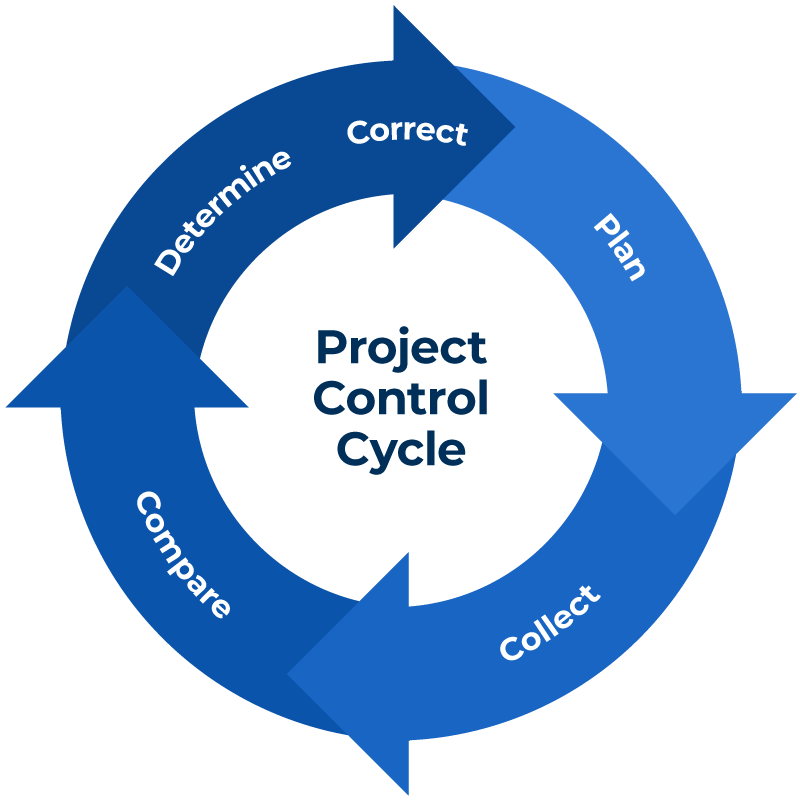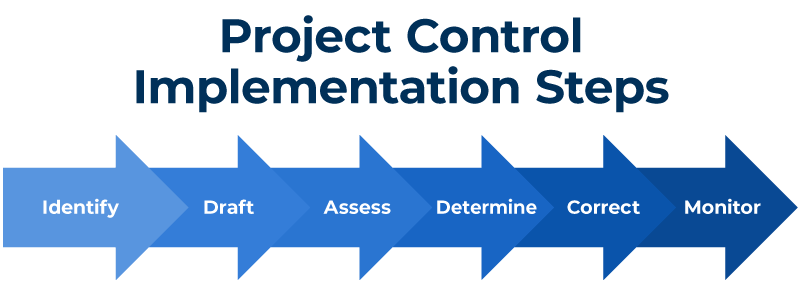“Everything You Need to Know About Implementing Project Controls” on SmartSheet, September 27, 2021. Primary subject matter contributor.
What Are Project Controls?
Project controls are processes that minimize the performance gap between planning and execution. While project controls often refer specifically to the monitoring and controlling stage of the project lifecycle, they are important from initiation to closure. Project control specialists use project controls to mitigate risk and solve problems in order to keep a project on time and budget.
What Are Project Control Processes?
Project control processes help ensure that performance meets standards. Control processes are data-driven, efficient, and highly visible. Project managers must first identify a performance problem, and then determine what caused it and how to fix it.
Instituting project controls involves a four-stage process:
- Establish performance standards to create a baseline.
- Measure performance through data collection.
- Compare performance to the baseline to identify deviations and determine their causes through data analysis.
- Correct the performance deviation to keep the project on time and on budget.
Importance of Project Controls
Project controls are vital to a project’s success. They help maintain scope, schedule, cost, and quality to minimize the waste of resources such as time and money. Project controls help the team make the best decisions to complete a project successfully.
Project Control Cycle
The project control cycle puts project controls into action. Follow each step and repeat the cycle in order to anticipate and fix deviations from the plan.
- Create a baseline plan for project performance and progress.
- Collect and measure progress data against the baseline.
- Analyze and compare actual progress and performance to the baseline.
- Identify and determine the causes of variations in performance from the baseline.
- Correct the deviation and repeat steps 2 through 5.
Project Control Methods
Project control methods should be precise and data-driven. A project manager needs to understand the problem, what caused it, and how to fix it to save time and money. Specific project controls perform particular functions.
- Project Charter: Successful projects begin with an all-encompassing overview, which you can provide by creating a project charter. A detailed project charter should list the critical components with precision and clarity.
- Responsible, Accountable, Consulted, Informed (RACI) Matrix: A RACI matrix defines project team members’ association according to their task assignments. Read our RACI guide to learn more about each association role and the value of a RACI matrix.
- Work Breakdown Structure (WBS): A WBS begins with a project outcome. Then, the structure breaks down the outcome into smaller deliverables and identifies the tasks necessary to deliver them.
- Critical Path Method: The critical path method helps you identify essential tasks of a project in terms of time. This six-step method divides a project into work tasks and calculates the time it will take to complete each task.
- Project Milestones: A project milestone is a specific point in the project lifecycle that marks important dates, such as the start, end, and review, and deliverable due dates. Find the best milestone template for your project in its working format in order to help your team achieve those milestones.
Components of Project Controls
Project control components inform project managers and teams to make better decisions and stay on task. Controlling these components puts an organization’s resources to best use in achieving project outcomes.
- Scheduling: Project control components begin with a project schedule that lists tasks and assignments, as well as the time required to complete them. A Gantt chart illustrates tasks and important dates along a project’s timeline and schedule.
- Costs: A cost management plan optimizes project resources in financial terms, which makes it a vital project control component. In this component, you estimate costs and anticipate financial risk in order to keep a project on budget.
- Risk: Project controls identify and mitigate risk for a project. Risk threatens projects and organizations, so it’s critical to have a risk management plan that identifies risks and predicts outcomes.
- Performance: Project controls work best during the monitoring performance phase, as they serve to identify baseline deviations, and then correct them. When you consider the primary function of project controls, this component immediately comes to mind.
- Communication: Project controls evaluate and report project status throughout the project lifecycle, so it’s vital to maintain clear and consistent communication with the project manager. Status reporting keeps the project team on task and provides stakeholders with valuable information.
How to Implement Project Controls
You should implement project controls at the project’s start, and they should be in place before forecasting begins. At this point, performance standards are already in place, so project controllers and control specialists implement controls when actual performance deviates from the baseline.
To do so, follow the below steps:
- Identify the issue.
- Draft an issue log.
- Assess the issue’s impact on cost and schedule.
- Determine how to resolve the issue.
- Correct the issue by implementing the solution.
- Monitor the solution to determine its effectiveness.
Project Control Department Functions
Project control departments advise project managers and keep project stakeholders informed to help them make the best decisions. Control departments operate externally and remotely to perform the following basic functions:
- Meet and assign control tasks to department members who specialize in them.
- Monitor project performance to identify problems.
- Create solutions to fix the problems and minimize risk.
- Report to and advise the project manager.
Best Practices for Project Controls
Skillfully administered project controls increase the likelihood of project success. Use the following project control best practices to optimize project team performance and project outcome:
- Tailor and contextualize project controls to the specific industry, project management style, or situation to save time and money. There is no one-size-fits-all approach when it comes to project controls.
- Be proactive. Project controls are more effective sooner than later. Reworking grows exponentially in terms of time and expense the further along a project is.
- Use key performance indicators (KPIs) to optimize team performance for specific tasks. Designing or finding the right KPI dashboard makes the difference.
- Implement project controls that promote accountability and empowerment in the project team.
Alan Zucker is the founder of Project Management Essentials, LLC and has more than 25 years of project leadership and management experience. He lists the benefits of project controls at specific parts of the project lifecycle: “Project controls at the front end of a project promote sticking to the objectives, avoiding redundancy or conflicting controls. During the lifecycle, controls identify problems, allowing for course corrections to determine feasibility. Back-end controls ensure the final project meets expectations, quality standards, and the specific needs of customers.”
Project controls deliver real-time status reporting for accuracy and transparency, and they boost confidence in the organization. Controls improve job satisfaction in the project team and provide benchmarks for future projects.
Challenges of Project Controls
With excellent implementation, monitoring, and analysis, project controls deliver. That said, it’s important to have an awareness of some common pitfalls in order to avoid them.
Alan Zucker offers this significant project controls challenge: “Highly controlled projects can hinder the process. Adequate project controls must meet the moment, and a good controls framework requires the proper project controls.”
Project control challenges can turn a project upside down, causing delays and cost overruns. Scope creep occurs when project deliverables and size increase due to unexpected problems. Identifying and understanding the causes of scope creep can help you get a project back on track and avoid the issue in future projects.
A change management plan and a risk register can help project teams tackle control challenges head-on. Projects with a change management structure in place control and adapt to change more successfully. A risk register evaluates risks and prioritizesthe most problematic ones in need of mitigation.




